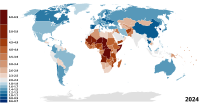
Photo from wikipedia
Mortality inequalities have been described across Latin American countries, but less is known about inequalities within cities, where most populations live. We aimed to identify geographic and socioeconomic inequalities in… Click to show full abstract
Mortality inequalities have been described across Latin American countries, but less is known about inequalities within cities, where most populations live. We aimed to identify geographic and socioeconomic inequalities in mortality within the urban areas of four main cities in Colombia. We analyzed mortality due to non-violent causes of diseases in adults between 2015 and 2019 using census sectors as unit of analysis in Barranquilla, Bogotá, Cali, and Medellín. We calculated smoothed Bayesian mortality rates as main health outcomes and used concentration indexes (CInd) for assessing inequalities using the multidimensional poverty index (MPI) as the socioeconomic measure. Moran eigenvector spatial filters were calculated to capture the spatial patterns of mortality and then used in multivariable models of the association between mortality rates and quintiles of MPI. Social inequalities were evident but not consistent across cities. The most disadvantaged groups showed the highest mortality rates in Cali. Geographic inequalities in mortality rates, regardless of the adults and poverty distribution, were identified in each city, suggesting that other social, environmental, or individual conditions are impacting the spatial distribution of mortality rates within the four cities.
Journal Title: International Journal of Environmental Research and Public Health
Year Published: 2023
Link to full text (if available)
Share on Social Media: Sign Up to like & get
recommendations!